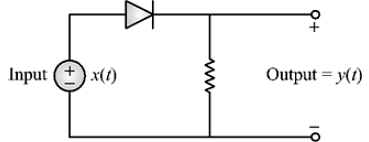Electrical Engineering (EE) Exam > Electrical Engineering (EE) Questions > Consider an ideal diode circuit shown in the...
Start Learning for Free
Consider an ideal diode circuit shown in the figure.

The system is
- a)Causal, linear and time-invariant.
- b)Non-causal, non-linear and time-variant.
- c)Causal, non-linear and time-variant.
- d)Causal, non-linear and time-invariant.
Correct answer is option 'D'. Can you explain this answer?
| FREE This question is part of | Download PDF Attempt this Test |
Most Upvoted Answer
Consider an ideal diode circuit shown in the figure.The system isa)Ca...
For the given circuit input output relationship is



Causality: The system is causal because output y(t) at any time t depends only on the present input x(t).
Linearity: Let input x(t) = u(t) then output will be y(t) = u(t) .
For the system to be linear, output for input au(t) must be au(t) . But for the given system
If a = -1, input is -u(t) and diode will be in reverse bias. Hence output will be 0.
Time invariance: For a delayed input output is

Delay in output,

Thus, y(t,to) = y(t - to)
System is time-invariant.
Remark
Diode is a non-linear device.
Attention Electrical Engineering (EE) Students!
To make sure you are not studying endlessly, EduRev has designed Electrical Engineering (EE) study material, with Structured Courses, Videos, & Test Series. Plus get personalized analysis, doubt solving and improvement plans to achieve a great score in Electrical Engineering (EE).

|
Explore Courses for Electrical Engineering (EE) exam
|

|
Consider an ideal diode circuit shown in the figure.The system isa)Causal, linear and time-invariant.b)Non-causal, non-linear and time-variant.c)Causal, non-linear and time-variant.d)Causal, non-linear and time-invariant.Correct answer is option 'D'. Can you explain this answer?
Question Description
Consider an ideal diode circuit shown in the figure.The system isa)Causal, linear and time-invariant.b)Non-causal, non-linear and time-variant.c)Causal, non-linear and time-variant.d)Causal, non-linear and time-invariant.Correct answer is option 'D'. Can you explain this answer? for Electrical Engineering (EE) 2024 is part of Electrical Engineering (EE) preparation. The Question and answers have been prepared according to the Electrical Engineering (EE) exam syllabus. Information about Consider an ideal diode circuit shown in the figure.The system isa)Causal, linear and time-invariant.b)Non-causal, non-linear and time-variant.c)Causal, non-linear and time-variant.d)Causal, non-linear and time-invariant.Correct answer is option 'D'. Can you explain this answer? covers all topics & solutions for Electrical Engineering (EE) 2024 Exam. Find important definitions, questions, meanings, examples, exercises and tests below for Consider an ideal diode circuit shown in the figure.The system isa)Causal, linear and time-invariant.b)Non-causal, non-linear and time-variant.c)Causal, non-linear and time-variant.d)Causal, non-linear and time-invariant.Correct answer is option 'D'. Can you explain this answer?.
Consider an ideal diode circuit shown in the figure.The system isa)Causal, linear and time-invariant.b)Non-causal, non-linear and time-variant.c)Causal, non-linear and time-variant.d)Causal, non-linear and time-invariant.Correct answer is option 'D'. Can you explain this answer? for Electrical Engineering (EE) 2024 is part of Electrical Engineering (EE) preparation. The Question and answers have been prepared according to the Electrical Engineering (EE) exam syllabus. Information about Consider an ideal diode circuit shown in the figure.The system isa)Causal, linear and time-invariant.b)Non-causal, non-linear and time-variant.c)Causal, non-linear and time-variant.d)Causal, non-linear and time-invariant.Correct answer is option 'D'. Can you explain this answer? covers all topics & solutions for Electrical Engineering (EE) 2024 Exam. Find important definitions, questions, meanings, examples, exercises and tests below for Consider an ideal diode circuit shown in the figure.The system isa)Causal, linear and time-invariant.b)Non-causal, non-linear and time-variant.c)Causal, non-linear and time-variant.d)Causal, non-linear and time-invariant.Correct answer is option 'D'. Can you explain this answer?.
Solutions for Consider an ideal diode circuit shown in the figure.The system isa)Causal, linear and time-invariant.b)Non-causal, non-linear and time-variant.c)Causal, non-linear and time-variant.d)Causal, non-linear and time-invariant.Correct answer is option 'D'. Can you explain this answer? in English & in Hindi are available as part of our courses for Electrical Engineering (EE).
Download more important topics, notes, lectures and mock test series for Electrical Engineering (EE) Exam by signing up for free.
Here you can find the meaning of Consider an ideal diode circuit shown in the figure.The system isa)Causal, linear and time-invariant.b)Non-causal, non-linear and time-variant.c)Causal, non-linear and time-variant.d)Causal, non-linear and time-invariant.Correct answer is option 'D'. Can you explain this answer? defined & explained in the simplest way possible. Besides giving the explanation of
Consider an ideal diode circuit shown in the figure.The system isa)Causal, linear and time-invariant.b)Non-causal, non-linear and time-variant.c)Causal, non-linear and time-variant.d)Causal, non-linear and time-invariant.Correct answer is option 'D'. Can you explain this answer?, a detailed solution for Consider an ideal diode circuit shown in the figure.The system isa)Causal, linear and time-invariant.b)Non-causal, non-linear and time-variant.c)Causal, non-linear and time-variant.d)Causal, non-linear and time-invariant.Correct answer is option 'D'. Can you explain this answer? has been provided alongside types of Consider an ideal diode circuit shown in the figure.The system isa)Causal, linear and time-invariant.b)Non-causal, non-linear and time-variant.c)Causal, non-linear and time-variant.d)Causal, non-linear and time-invariant.Correct answer is option 'D'. Can you explain this answer? theory, EduRev gives you an
ample number of questions to practice Consider an ideal diode circuit shown in the figure.The system isa)Causal, linear and time-invariant.b)Non-causal, non-linear and time-variant.c)Causal, non-linear and time-variant.d)Causal, non-linear and time-invariant.Correct answer is option 'D'. Can you explain this answer? tests, examples and also practice Electrical Engineering (EE) tests.

|
Explore Courses for Electrical Engineering (EE) exam
|

|
Suggested Free Tests
Signup for Free!
Signup to see your scores go up within 7 days! Learn & Practice with 1000+ FREE Notes, Videos & Tests.






















